 It’s rare that I’m stuck for words but this time I was speechless. To quote Sienfelds’s George, “I was without speech.” There seems to be a craze in the young mother stratum of the USA for something called a Cake Smash. In brief, at their first birthday party, children are given, all to themselves, a small cake, placed centre stage which they are encouraged to “smash”, tear apart, lunge into, smear over clothing and eat. Meanwhile, adults coo, take pictures and laugh indulgently. I have to assume that this is for the amusement of the adults because no child will fully understand what’s going on, apart from sometimes it’s naughty to play with your food and sometimes it's not. This little exercise of course engenders a host of marketing opportunities. There are special outfits for children to smash in, special little cakes to be ordered. (It’s strongly recommended to have a nice soft sponge that’s easily broken and to stay away from fondant icing that can become firm, hard to smash and difficult to smear around the face and clothing. It’s also recommended that one avoid chocolate and berry sauces, the colours of which can suggest unpleasant bodily situations.) Then there’s the professional photography to take into consideration. Photographs can be snapped during the event, but it’s also recommended that a separate photographic session take place at another, quieter time, when the stage can be set and the child "emotionally prepared" for the event. One “Professional Cake Smash Planner” suggests that if your baby isn’t too sure about the cake, try putting a bit on your finger to pop in their mouth. If they haven’t had much experience with cake, they might not know it’s edible. Gee, how very annoying! Is the Cake Smash producing more discerning eaters, more elegant behaviour? Is it teaching us about waste or the waistline? The word "cute" has a lot to answer for. Watch out for this craze. It’s coming. An English newspaper reports that Millennials turning thirty want to get some action too. See Millennial Cake Smash for some charming photos. In the meantime, here we’re seeing a lot of serious “cake shaming” where you must make sure that your child’s birthday cake is bigger, better, funnier, more inventive, whackier than that of his or her peers. The French 17th C writer, François de La Rochefoucauld observed that in life, it’s not enough that you succeed but a friend should fail a little. (Shudder!) Comment / Like below
8 Comments
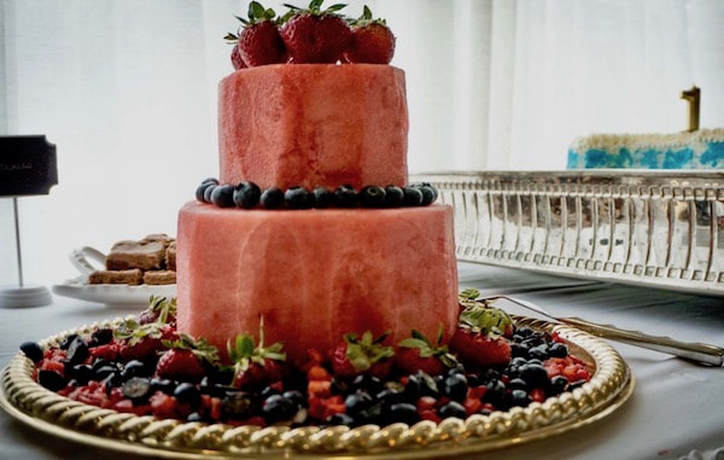 Recent studies show (one of my favourite expressions) that eating sugar does not make children hyperactive. It's probably the situation in which children find themselves - parties, the beach, groups of friends etc - that makes them hyperactive, and the sugar just happens to be there. It's an interesting proposition. That said, no-one is encouraging the over-eating of sugar without any balancing goodness e.g. fruit is sugar but it also contains so much more. So how about this wonderful watermelon birthday cake for my niece's little treasure in New York? To the right is the traditional birthday cake, blue icing for a boy and a proud number one stuffed into it. Interestingly, she told me the children at the party demanded and devoured the watermelon, leaving the cake for the adults! Comment / Like below 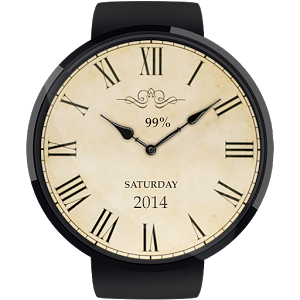 Punctuality means different things in different cultures. A meeting at 11.00 in some societies could mean any time that day (later never earlier) and to be on time might look servile. Here we accept that getting together at an agreed time is fairly rigid. “Catch you for a coffee at 2.00,” would mean between 2.00 and 2.05. Meetings, business and medical appointments should start on time and therefore arriving five minutes beforehand is essential and respectful. Accepting an invitation to eat together at someone’s house at 7.00 would mean between 7.05 (not 7.00) and 7.15. Too early and you catch the hosts in disarray. Baroness Nadine de Rothschild offers the “quart d’heure de politesse” (a quarter of an hour for politeness.) A cocktail party can only swing if everyone gets there within the first half hour. (Come on, they only last for a couple of hours so respect that you've been asked.) We’ve all had problems with arriving on time – road works you knew nothing about, a booked taxi that failed to arrive. (But Uber and mobiles have surely fixed that?) But failing disaster, being on time is a gesture of respect and grace. Your time is not more valuable than anyone else’s and you’re not “entitled” to allow your inefficiency to involve others. "I'm late because I was making you a cake," won't wash with me. I'm excited and looking forward to seeing you. So here’s a social and diplomacy dilemma I experienced recently. A friend (I’ll call him Ludo) was invited to eat with us at 6.30 p.m., making six at table. (Yes dreadfully early but we’re all getting older and as Lizzie says, “We all need a drink by then”.) Ludo texted to say he’d be there at 6.15. Now, Ludo is generous to a fault. A bachelor, he flings French Champagne (tautology) and flowers at an invitation with sincerity and abandon. I texted back to say (tactfully) that I was happy he could join us and that 6.30 would be fine. We waited and waited, not knowing whether to open another bottle or call the hospital. He arrived finally at 7.28. Why? Dressed and ready to leave, a friend he hadn’t seen in a while rang his bell and Ludo invited him in and offered him a drink. Guests shouldn't have to wait more than forty minutes to sit down. Should we have sat down and started? Where does the loyalty or obligation lie? Are there any concerns about the others waiting? When can we say no? (What would Prince Harry have done? What would you have done?) Just a few trays...Royal Doulton "Yvonne", Wedgwood black basalt, Arabia, Waechtersbach, Limoges, Spode, Rosenthal, Arzberg...
Finally, the new carpet is to go down. (It took a while to find the colour. It seems no-one does colour any more - it's wall to wall beige, taupe, grey, steel, cream, brown or taupe.) Had to move the furniture in the sitting room. This meant emptying one of the sideboards. A dear friend helped. Because it's not her house, she could be brutality impartial and sensible. We found, among other things, coffee cups for 73 guests. I haven't mentioned the teacups. Am I a hoarder? No, I'm a collector. A collection is only as good as your retrieval system. And I can tell you that my retrieval system is now a lot better. Notice I said "one of the sideboards". Soon, Rosa will come over, have a ristretto in one of the coffee cups and we'll get down to sorting the rest. I use everything and get much pleasure from it. I don't have ordinary and "for best". But I think there is definitely a garage sale coming up - a well curated garage sale of course. Comments or Like - see below to add... 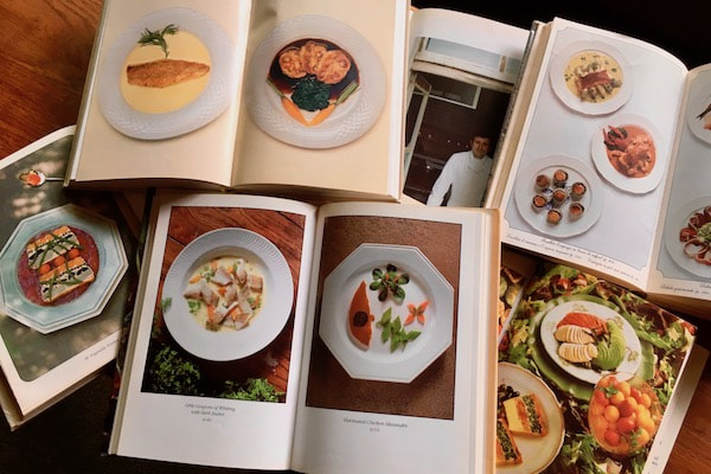 The books we had to have - the terrines, the fans, the coulis... (Spoiler alert – Nouvelle Cuisine is NOT Cuisine Minceur) In 1969, two young journalist in Paris, Henri Gault and Christian Millau set up a new magazine (Gault & Millau – le Nouveau Guide) to rival the staid Michelin system of grading restaurants. Michelin gave an overall score that included atmosphere, décor and food (causing restaurants to spend lavishly on new lavatory facilities and extravagant flowers to win a third star). Gault and Millau scored the food only, and simply commented on the rest. By 1973, they were noticing changes in the menus and on the plate – a new delicacy; lightness, simplicity and elegance. They spoke of “la nouvelle cuisine” and the expression “went viral”, as they’d say today, aided and abetted by a rash of cook-book publications, all of which we collected avidly. At the forefront was Paul Bocuse, but also significantly Michel Guérard, Jean and Pierre Troisgros, Roger Vergé, Alain Chapel and Alain Senderens (for whom I translated in the mid 80s when he came to Australia). Interestingly, they all had been classical trained. Gault and Millau listed ten commandments or observations. There are still negative connotations to Nouvelle Cuisine as a result of poor cooks just playing with colours and strange combinations. I know of a chicken breast stuffed with macadamia nuts on a bed or puréed beetroot with a kiwi fruit coulis! Nouvelle Cuisine, cooked with integrity, was a very important movement that still resounds today, both at home and in restaurants. Just a few observations… Lighter, shorter cooking times for vegetables, meat and especially fish, often served pink in the centre. Vegetables were no longer water logged but tasted of themselves. (Unfortunately it also could mean squeaky vegetables and they’re still around. I loathe hot, raw vegetables. Give beans exactly seven minutes – perfect.) Use produce that’s in season so check the market before planning the menu. Lighten and shorten the menu and abandon the orthodox, tightly prescribed canon. A classic Tournedos Rossini, for those in the know, was a fillet steak cut from the central portion of the full “undercut”, cooked rare to medium rare, served on a crouton, topped with a slice of foie gras and a black truffle, coated with a Madeira brown sauce. Delicious, but the kitchen would never deviate. If you used Port in the sauce, it was no longer Tournedos Rossini. Now you could add and subtract (even introduce Asian ingredients). Dishes were described by their ingredients (which later lead of course to some places going to ridiculous lengths, listing every ingredient in a dish, like a shopping list). Check out new techniques and new technology. The Magimix hit our benches and we’ve never looked back. This opened up a world of fish mousses and purées that would have taken so many person-hours. Abandon lengthy marinades and hanging of game so that food could taste freshly of itself. Lighten sauces so as not to mask the food. Sauces had been heavily intense and lightly thickened with flour. Now sauces were a gentle reduction and rather than coating and masking the food, sat beneath it. The dish that comes to mind, served by many chefs, was a beautifully poached or steamed piece of salmon sitting simply on a very pale sauce of cream, white wine and stock enhanced with sorrel. (But once again the aberrations gave rise to colour and flavour combinations that were garish rather than gastronomic.) Take health and well-being into consideration. Although butter and cream were still lavishly used (and we know now that was fine) the first course could be a composed salad – e.g. thinly sliced cured duck breast with frizzy lettuce, grilled peaches and toasted hazelnuts. Dishes did not really become small, just lighter and the flavours clearer. Do not over decorate the food. Chefs became more responsible for plate presentation, the elements more clearly seen on a large plate (lots of Villeroy & Boch) - often a Japanese sensibility. Everything on the plate was edible - no dessert with an obligatory half strawberry (often unripe) and mint leaf. (Think of the later silliness of food with "height" and the overwrought decorations we might see today.) Allow creativity with ingredients and even borrow from regional and other ethnic cuisines. Question standard practices. Alain Senderens shocked the food world by suggesting that most white wines were more suitable for cheese than red wine. He also introduced wine pairings for the dishes on his menu. We take these changes for granted. Now, what’s not to like? Comments / Like - see below to add...  Michel Guérard was classically trained in both cookery and pâtisserie. He opened his first restaurant (Le Pot-Au-Feu) in Paris in 1965, received his first Michelin star in 1967 and his second in 1971. The restaurant was forced to close in 1972 due to a major road works, at the same time that he met his future wife. He was a significant player in the movement known as Nouvelle Cuisine but along side this, he developed what he called Cuisine Minceur. This is the story. In 1972, he met Christine Barthélemy. She was the daughter of the founder of Biotherm (skin care products - big on seaweed) who also owned a string of spa hotels. She liked his marriage proposal (who wouldn't fall for that warm, friendly charm?) but suggested he might like to lose a little weight. Cuisine Minceur was born along with a clever book - a best seller. Together they renovated the spa at Eugénie-les-Bains (S.W. of France) where he not only set up his new restaurant (soon to receive the third star) but also offered a health spa with treatments and a special menu. For the spa restaurant, he developed a cuisine that was delicious, elegant and light but still with an air of pampering luxury. Sauces were often puréed vegetables, fish was steamed over herbs, there were even desserts. Look into Potted Salmon with Lemon, Green Peppercorns and Sauce Grelette or Floating Islands with Blackcurrant Sauce. Strangely, the book came out in Australia even before his Cuisine Gourmande. I question how much it was used by the general public. There are beautiful recipes that I still use although you lose nearly as much weight putting them together as you do eating them! (As to his other book, Cuisine Gourmande, I challenge anyone to work through it and not come out a better cook. Both books are still published but you can find them readily in second-hand book stores or at garage sales.) Incidentally, to visit or make a booking (haha) http://www.michelguerard.com Below, Christine and Michel, together at Eugénie-Les-Bains. Comments / Like - see below to add...
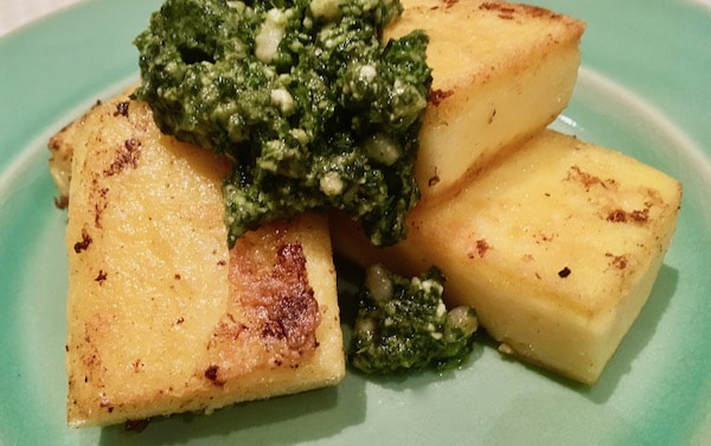 Crisp polenta & chunky pesto - easily helped by the Thermomix Someone has asked about the Thermomix, (wondering why, I presume, I didn’t call on its services when I was “without stove” for five days?) A few years ago, after an extremely busy time at the restaurant leading up to the end of the year, I felt I needed a personal present and bought a Thermomix. I love it, but wouldn’t recommend it to everyone. Here are my pros and cons. In case you don’t know, the Thermomix is a combination food-processor – blender with built-in cooking ability. In restaurants you would need a bank of them. (The erstwhile El Bulli had six, I believe.) They are definitely for home use. There have been claims against Thermomix for accidents while using. This I put down to the fact that it’s very powerful and needs to be sold only to sensible, intelligent people who will treat its power with respect. It’s large and takes up lots of bench space. It’s quite noisy in operation. You can have faith in its German engineering. I’ve heard raves and sighs at how good it is for baby food. It makes marvelous baby food but then again, babies grow up. All the food prepared in it is “sloppy” food. My uses
Frankly I could love it for the polenta and hollandaise alone but is the price tag worth it to you? Perhaps I haven't explored the suggestions of the on-line "community" enough.
I’m told about someone who knows someone whose niece knows someone else who uses it all the time. Not sure what that means but it does tell me that, all the time, they’re eating sloppy food. If you’ve got the bench space, can blow a couple of thousand or are simply bored, you might look forward to the polenta. I’d recommend an ice-cream making machine or an upgrade on your Breville Whiz if you don’t have “the really good food processor”. Thermomix Polenta (4 -6 depending on how you use it) This works very quickly so have all ingredients ready to hand.
Add
Pour immediately into a bowl and serve or better still, pour into a dish approx. 150cm x 270cm. Cool, cut into squares or slices, brown in butter and serve. *Polenta can be "enriched" by using part water part stock or part water part milk. **There is no salt because the Parmesan is salty. For next time, season with a little salt if you think it's needed. Nutmeg is also nice. Thermomix Pesto Throw into the Thermomix bowl...
Scrape into a bowl. Wonderful fresh but will keep for several weeks in the refrigerator. Comments - see below to add... |
Categories
All
|
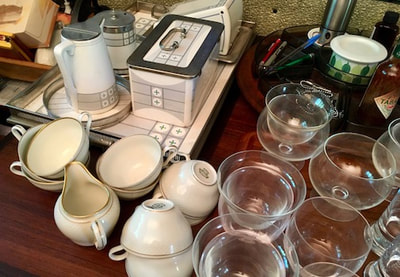
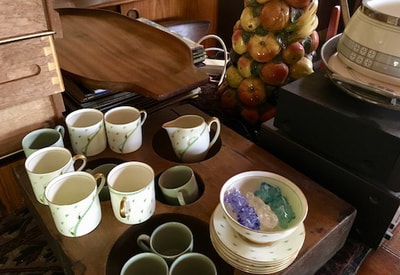
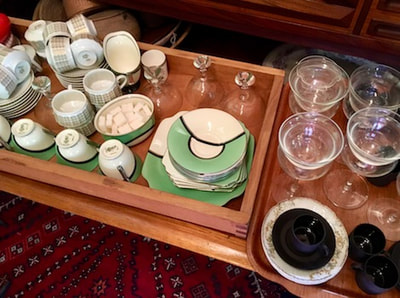
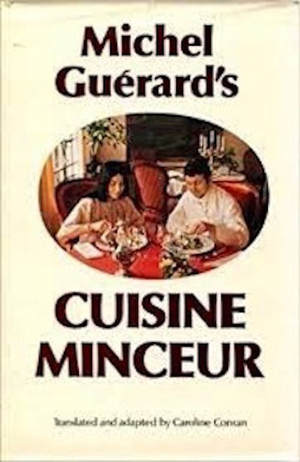
 RSS Feed
RSS Feed
